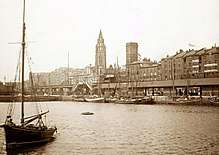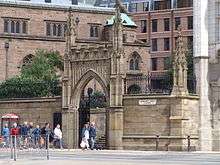George's Dock
George's Dock was a dock, on the River Mersey, England, within the Port of Liverpool. It was connected to Canning Dock to the south and George's Basin to the north.
| George's Dock | |
|---|---|
 An 1897 postcard of the dock, looking towards Church of Our Lady and Saint Nicholas, Liverpool | |
| Location | |
| Location | Liverpool, United Kingdom |
| Coordinates | 53.4050°N 2.9954°W |
| OS grid | SJ338903 |
| Details | |
| Opened | 1771[1] |
| Closed | 1899 |
| Type | Wet dock |
| Area | 5 acres (2.0 ha), 2,593 sq yd (2,168 m2)[2] |
| Width at entrance | 41 ft 11 in (12.78 m)[3] |
| Quay length | 1,001 yd (915 m)[3] |
History
Construction of the dock began in 1762, and was known as North Dock prior to completion.[1] The dock, which opened in 1771, was designed and built by Henry Berry and named after the reigning monarch, King George III.[1] The dock basin originally covered an area of slightly more than 3 acres (1.2 ha).[1] The Goree Warehouses were built to the east of the dock in 1793, and severely damaged during a fire in 1802 which caused over £320,000 of damage.[1] The dock was rebuilt and expanded between 1822–5, after losing its American and Caribbean shipping to Prince's Dock,[1] being expanded by John Foster, Sr.. Following the rebuild and expansion, the dock was mainly used by schooners carrying perishable goods.[1]
The adjoining George's Basin was filled in 1874.[1] In 1899-1900 the dock was filled in to create what is now the Pier Head,[1][4] to provide one central place for Liverpool Docks' offices, which before were scattered across different sites. A section of the original George's Dock wall is still visible in the basement of the Cunard Building which stands on the site.[5] The Goree Warehouses, which had been named after a slave market in West Africa, were destroyed by bombing during World War II.[6]
By March 2009, work was completed[7][8] on a £22 million extension of the Leeds and Liverpool Canal on the site of the former basin. The canal extension provides a further 1.4 miles of navigable waterway.[9]

References
- McCarron & Jarvis 1992, pp. 39–41
- Baines 1859, Part II, p. 96
- Baines 1859, Part II, p. 116
- "Trading Places: A History of Liverpool Docks". Liverpool Museums. Archived from the original on 30 September 2009. Retrieved 16 September 2008.
- "Cunard Building: History". CB Richard Ellis. Archived from the original on 7 October 2011. Retrieved 8 July 2009.
- "Old Photographs & Drawings of Liverpool". chesterwalls.info. Retrieved 8 September 2016.
- "Liverpool Canal Link, March 2009 (Page 2: Pier Head)". Pennine Waterways. Archived from the original on 27 November 2010. Retrieved 8 July 2009.
- "New canal link to boost tourism". BBC News. 25 March 2009. Retrieved 8 July 2009.
- "Liverpool Canal Link: The Scheme". British Waterways. Archived from the original on 28 July 2009. Retrieved 8 July 2009.
Sources
- Baines, Thomas (1859). Liverpool in 1859. London: Longman & Co. OCLC 43484994.CS1 maint: ref=harv (link)
- McCarron, Ken; Jarvis, Adrian (1992). Give a Dock a Good Name?. Birkenhead: Merseyside Port Folios. ISBN 9780951612941. OCLC 27770301.CS1 maint: ref=harv (link)
External links
- "Liverpool North Docks diagram". Archived from the original on 6 January 2009.
- Site of Georges's Dock aerial photo